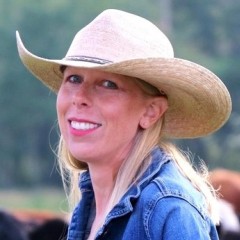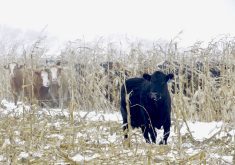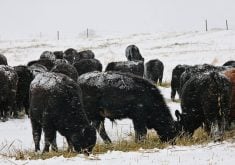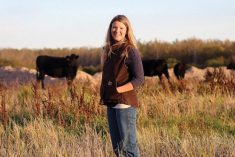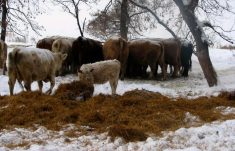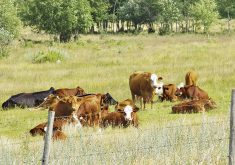Is your pasture above- or below-average?
And if you don’t keep accurate records over time, how do you know?
The first step is knowing what your land is capable of producing so you can set a proper grazing rate, says Ryan Boyd.
Read Also

Farming Smarter receives financial boost from Alberta government for potato research
Farming Smarter near Lethbridge got a boost to its research equipment, thanks to the Alberta government’s increase in funding for research associations.
That was driven home for the Manitoba producer when he was awarded a Nuffield scholarship and was able to visit one of the world’s top grazing experts.
“On my Nuffield travels, I spent the afternoon with Jim Gerrish, and he recommended taking a pasture inventory every two weeks,” said Boyd, who ranches near Brandon. “You need to know how much forage you have, how much feed you have.”
There are publications with general stocking rates based on soil type and you can get further help from your local forage association or a rangeland agrologist, he said during a Beef Cattle Research Council webinar in late March.
Boyd practises something called Ultra High Stock Density grazing involving a high number of cattle on a small tract of land. Multiple moves a day allow for even distribution of manure and nutrients, as well as a more efficient way to harvest forage.
To plan, manage and evaluate all those moves takes good records — although don’t be intimidated by the process, said Boyd.
“I would never profess to say we have any of these done to perfection, but this is certainly what we are trying to keep a record of.”
He tracks five things: rainfall, pasture inventory, pasture productivity, biological indicators, and animal performance.
“All of that comes together to hopefully produce a profitable system with desirable environmental outcomes,” said Boyd.
Keeping track of rainfall is a simple, yet effective tool for pasture management.
“Knowing where you sit — how close or how far from a drought are we,” is how Boyd describes it. But he said effective rainfall is more important than the rainfall itself — looking for water infiltration and trying to maximize that.
Next, Boyd tracks pasture productivity.
“We like to measure that in terms of animal unit days per acre,” he said.
Technology and apps play a role in keeping track of all the info he collects.
“Out in the field we have a WhatsApp group chat. We snap a picture of the area that we are going to graze (including photos of the forage and cattle), and then back in the office that gets transferred to a Google Sheet that we can reconcile at the end of the year and tally up just what the animal grazing days per acre were,” he said.
He also tracks the date of grazing and the stock density for that piece of land.
“We’ve experimented with different apps on the phone to keep track of grazing records, (but) we keep reverting back to a spreadsheet-type record,” he said. “It’s simple, we can tailor it to our own needs and it’s free.”
He also uses an app called Area & Distance — Map Measure to measure out new paddocks for the cattle to graze. Printouts from Google Maps are in his farm shop showing pastures and water lines.
Animal performance is another aspect Boyd tracks on his farm, although he admits regularly weighing animals is “something to be improved upon.”
Yearling performance is especially important.
“At the end of the year we want to know a gain per acre when we’re trying to figure out our gross margins — we need to know those numbers.”
Body condition is also tracked: “Are they adding fat cover or declining condition.”
But the condition of his land is equally critical.
“We have benchmark soil tests on every field or quarter section,” he said, adding some fields or quarters have multiple soil test locations.
Boyd has been collecting soil information for more than 20 years and has one site that serves as a carbon benchmark.
“We can tell over time if there’s any major changes in nutrient content, organic matter or pH.” But there are other indicators of how the land is doing, he added.
“We want to see that plant density is increasing on the ground. Litter cover is at a desirable level and decomposing on the soil surface. The ground is covered so we’re in a position to soak in all the rain possible. That also relates to the surface roughness. We don’t want to have a smooth surface where the water hits it and runs off.”
Boyd also monitors forage quality.
“It is really fascinating to watch the forage quality change over time,” he said.
For example, in a newly sown stand, the first year the mineral content of the plants is much lower than forage that has been established for four to five years.
“We used to test monthly, and then we went away from that. Now, we’re starting that up again this year.”
Although he is “monitoring constantly in our grazing program,” Boyd cautions to not get carried away looking at the numbers on the spreadsheet.
“The results on the spreadsheet have to reconcile in the field. Are we accomplishing the landscape goals, the animal performance goals — it all has to come together to work as a whole.”
The Beef Cattle Research Council has a carrying capacity calculator at www.beefresearch.ca — click on the Resources tab and then on Decision Making Tools. That web page also has links to forage and grazing resources.

